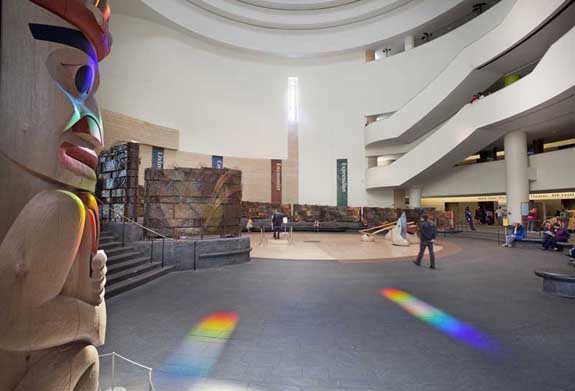Summer Solstice Shines Light at the American Indian Museum
The longest day of the year arrives today with a natural light show in the Potomac Atrium
Celebrate the summer solstice by checking out this mesmerizing display of color in the Potomac Atrium. Image courtesy of the National Museum of the American Indian.
Welcome to summer! Today is the first official day of the season, though the temperatures in D.C. climbing into the mid to high 90s over the past few weeks have suggested otherwise. The summer solstice, the longest day of the year, officially arrives at 7:09 P.M. (EDT) in the Northern Hemisphere. And as you bask in the glory that is summer, don’t miss the National Museum of the American Indian‘s celebration of the changing seasons at the Charles Ross’ Prism/Solar Spectrum installation in the south-facing window of the Potomac Atrium.
As the sun reaches its highest point in the sky, the light will hit eight large prisms inside a tall rectangular window in the atrium of the NMAI just so, creating a solar spectrum projection. Light passes through these prisms year round, but at the solstice, when the Earth tilts closest toward the sun, the light bands transform into a mesmerizing rainbow display. Growing stronger through the early afternoon, the colors stack in a straight line on the floor of the Potomac, creating a prism-playground for museum-goers.
This phenomenal light show is no accident. Lead design consultant JohnPaul Jones (Cherokee/Choctaw) details his inspiration for the atrium spectacle in the NMAI’s book The Land Has Memory:
“One day as we met to discuss the building’s progress, Donna House asked me to stand with her next to a window,” he wrote. “As sunlight poured in through the glass, she placed her closed hand in the light and then opened it so that the crystals she was holding made a rainbow pattern on the ceiling and walls beside us. It was her inspired design concept that led to the magnificent prism window mounted in the south wall of the Potomac Atrium.”
He kept ancient traditions in mind when mapping out the museum atrium. For centuries, the connections between the celestial world and the cycles of the seasons have tied indigenous peoples to earth. The natural world, to the American Indian, governs all living things, determining what crops they will yield, when they will harvest and which rituals they will perform. For this reason, seasonal solstices and equinoxes remain a symbol of transition and growth.
Go check out the celebration on your lunch break, since the projections are at their height between 11:00 a.m. and 2:00 p.m. If you can’t make it to the museum this year, here are six other ways to celebrate the summer solstice.
/https://tf-cmsv2-smithsonianmag-media.s3.amazonaws.com/accounts/headshot/561436_10152738164035607_251004960_n.jpg)

/https://tf-cmsv2-smithsonianmag-media.s3.amazonaws.com/accounts/headshot/561436_10152738164035607_251004960_n.jpg)